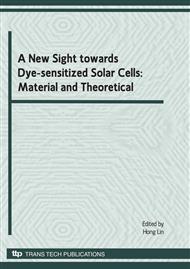p.1
p.21
p.29
p.41
p.63
p.79
p.97
p.123
Dye-Sensitized Solar Cells Based on Nitrogen-Doped Titania Electrodes
Abstract:
Dye-sensitized solar cell(DSC) is a new type of photovoltaic device. This paper mainly describes the research results of the development of a novel nitrogen-doped photoanode for DSC in our group. Highly efficient dye-sensitized solar cells (DSCs) of 7.6-10.1% were fabricated using nitrogen-doped titania electrodes. The photoelectrochemical properties of the nitrogen-doped titania powder, film, and solar cell were systemically investigated. We confirmed the substitution of oxygen sites and oxygen deficiency with nitrogen atoms in the titania structure by X-ray photoemission spectroscopy (XPS). The UV-Vis spectra of the nitrogen-doped powder and film showed visible light absorption in the wavelength range between 400 nm and 535 nm. The results of the stability test indicated that the DSCs fabricated by the nitrogen-doped titania exhibited great stability.
Info:
Periodical:
Pages:
21-27
Citation:
Online since:
November 2010
Authors:
Price:
Сopyright:
© 2011 Trans Tech Publications Ltd. All Rights Reserved
Share:
Citation:



